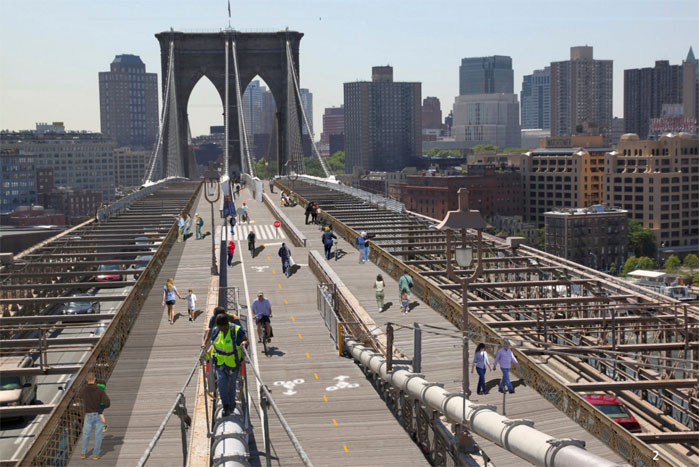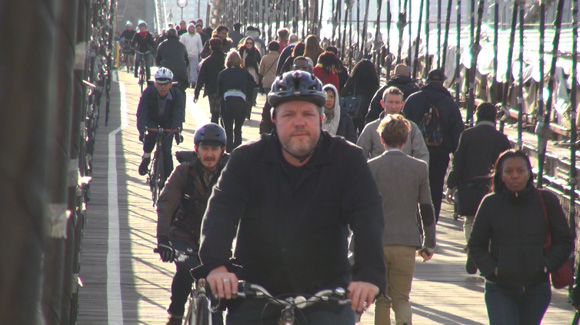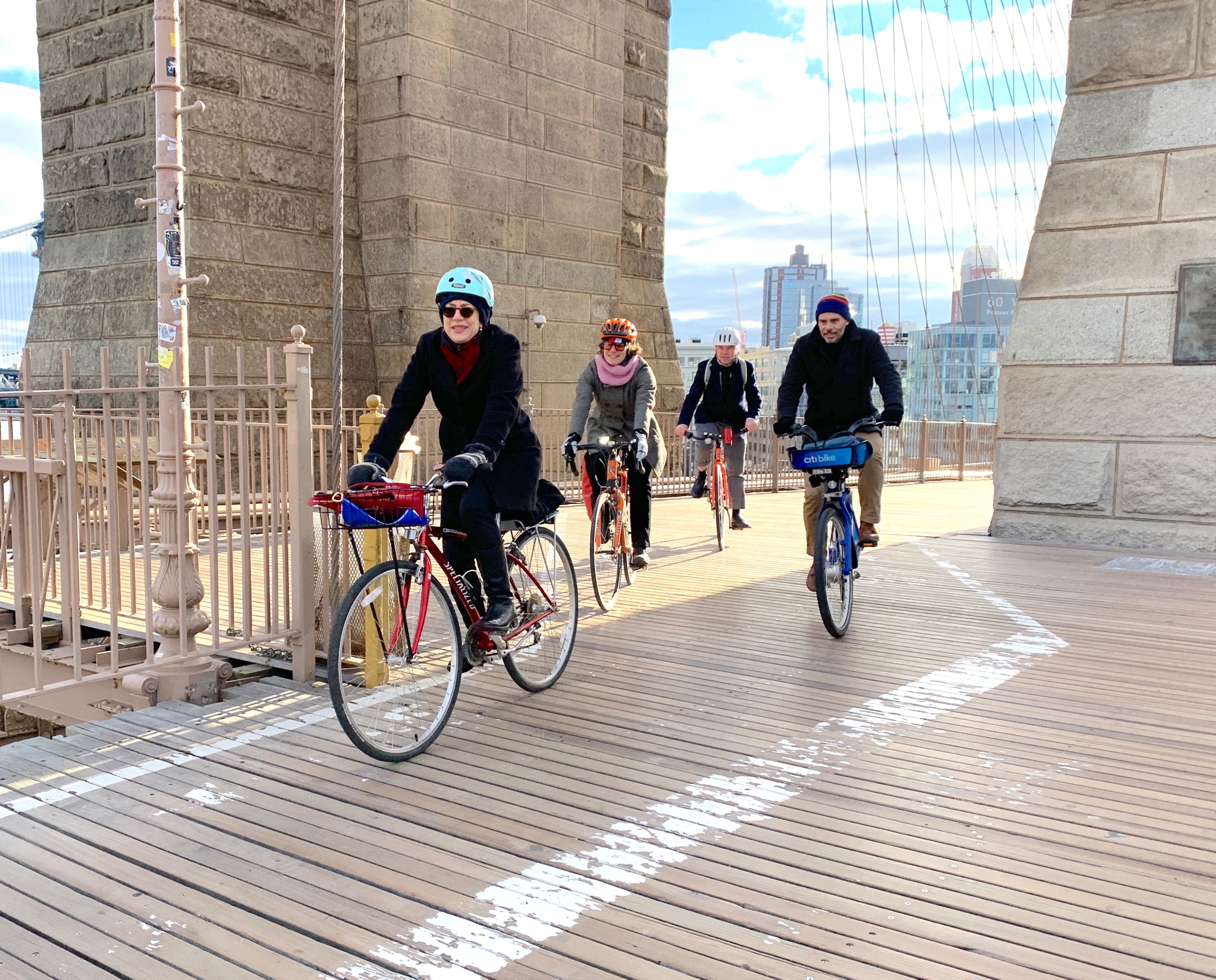Department of Transportation Commissioner Polly Trottenberg apologized Wednesday for the latest delay in fixing dangerous conditions on the Brooklyn Bridge bike and footpath — the subject of years of discussion but very little action.
At an unrelated press conference at the foot of the fabled span, Trottenberg blamed the delay in completing a key bridge inspection on "only-in-New York-City" reasons, but did not offer specifics.
"I will admit we have had some ups and downs," Trottenberg said when Streetsblog asked for an update on an expansion of the crowded walk- and bikeway that is an international tourist attraction as well as a key commuter route to Lower Manhattan.

Any changes, Trottenberg has long said, must wait until the completion of an inspection of the 137-year-old bridge's cables. That process was supposed to start last year.
"The bridge is a delicate beauty," Trottenberg said. "We have been in the process of trying to procure engineering services to do that cable inspection and I'm just going to confess it has proven to be a little bit more complicated to get that done for a whole host of convoluted, only-in-New-York-City reasons. But we are going to try to get that done as soon as we can.
"I apologize because it has taken longer than we thought it would," she added. "As soon as we have that cable study done, we will be able to think about what we might be able to do."
Trottenberg did not even pause to allow Streetsblog to ask the obvious follow-up.
"Now I know your next question is going to be, 'Why don't you take a lane of [car] traffic.' I know you..."
She does. But it's logical to ask about reconfiguring the car lanes on the bridge, given that congestion pricing, which begins next year, will reduce car demand on the bridge, making it possible to, perhaps, reclaim some of the span's public space for cyclists and pedestrians, who are often the primary users. Indeed, when the bridge opened in 1883, it carried no car traffic at all.
Trottenberg said the agency is "definitely thinking about" the affect that congestion pricing might have on major corridors into Manhattan.
"We are talking to our counterparts in London and Stockholm," she said, mentioning two cities with various forms of congestion pricing. "But it's a little too soon to say." (She notably did not mention Paris, where Mayor Anne Hidalgo has reclaimed entire roadways from car drivers.)

Trottenberg's comments are the latest chapter in a saga that dates back to August, 2016, when the DOT announced it had retained the engineering firm AECOM to study the structural feasibility of expanding the promenade deck between the towers. In late 2017, however, the agency said it couldn't do anything until it completed an inspection of the cables on the then-134-year-old span.
That inspection was supposed to begin in 2019. It's clear that it did not. (After initial publication of this story, a DOT spokeswoman issued the following statement: "DOT is already in talks with a small number of qualified firms, and we estimate being able to begin cable inspections this April, with preliminary results available by June.").
Cyclists and pedestrians and their advocates have been pressing the city to repair the dangerous conditions on the bridge for at least a decade, most recently in a letter from three Council Members to the DOT last July. Failure to fix the problem is costing taxpayers dearly. In 2017, the city settled a 2011 suit filed by cyclist Donald Olenick who was knocked off his bike when a pedestrian jumped in front of him, causing him to "sustain injuries including a fractured wrist and arm, and deep lacerations and abrasions to his face, knee, and fingers," according to court papers.
The city had argued that the case should be dismissed because "its design of the pathways is shielded from liability by governmental function immunity." A judge disagreed, the case proceeded, and the city finally settled it, paying Olenick an undisclosed sum.
Around the time of that payment, Manhattan resident Carolea Goldfarb was biking up the Manhattan side of the bridge — at the bottleneck caused by illegal vendors — when a pedestrian stepped in front of her, causing her to fall off her bike and break her fingers. She also suffered "pain, shock and mental anguish," according to court papers.
"These injuries and their effects will be permanent," her filing added.
As had Olenick, Goldfarb blamed the city for her injuries because the bike path is not properly marked and secured to keep cyclists and pedestrians from mingling.
"[The city has] a duty to keep the roadway, bicycle path and pedestrian walkway ... in a safe, proper and secure manner," Goldfarb argues in court papers. Failing to do so is basic "negligence."
Goldfarb's lawyer, Cathy Flanzig, citied the earlier Olenick case her in papers, which were filed on Aug. 2, 2018 and are pending.
"The city is still not doing what they say they're supposed to do: paint it, inspect it and make sure it's safe," Flanzig said. "No one else is holding the city accountable. And every lawsuit brings attention to the fact that each time a cyclist is injured, the city had knowledge that this same thing has happened before."






